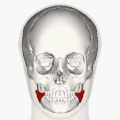| Risorius | |
|---|---|
 Superficial muscles of the head and neck, showing the risorius in red. This version of the muscle does not match that shown in most sources. | |
 Muscles of the head, face, and neck. Risorius shown in red. This is the most standard version of the direction and origin of the muscle. | |
| Details | |
| Origin | Parotid fascia |
| Insertion | Modiolus |
| Artery | Facial artery |
| Nerve | Buccal branch of the facial nerve |
| Actions | Draws back angle of mouth |
| Identifiers | |
| Latin | musculus risorius |
| TA98 | A04.1.03.028 |
| TA2 | 2078 |
| FMA | 46838 |
| Anatomical terms of muscle | |
The risorius muscle is a highly variable muscle of facial expression. It has numerous and very variable origins, and inserts into the angle of the mouth. It receives motor innervation from branches of facial nerve (CN VII). It may be absent or asymmetrical in some people. It pulls the angle of the mouth sidewise, such as during smiling.
